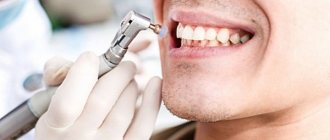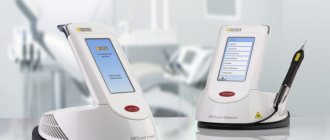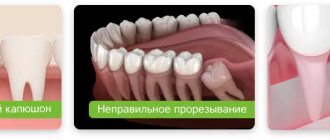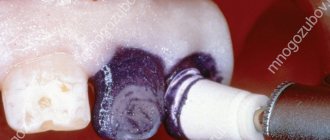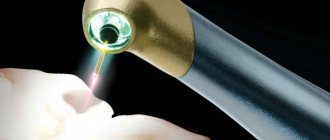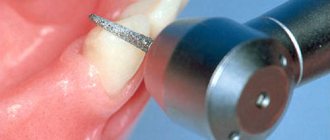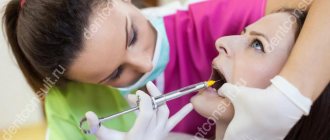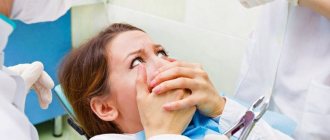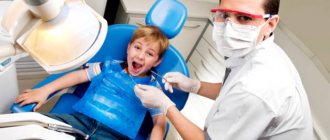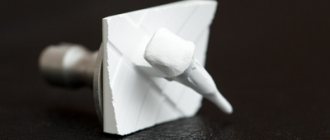HomePeriodontologyTreatment of gum inflammation with SIEMENS laser
Dental clinic "Bionic Dentis" is the only dental clinic in Moscow and the Russian Federation that uses the German method of treating gum inflammation with laser and active prf regeneration proteins, which gives a positive result in 100% of clinical cases!
If you want to know more, read our article:
Gum inflammation
Gum inflammation in modern society is one of the most common diseases with which patients go to the dental clinic. The gums begin to hurt due to a variety of diseases. Patients are given various diagnoses: gingivitis, periodontitis, periodontal disease, but all these medical terms have one thing in common - the presence of an inflammatory process in the gingival tissue and periodontal inflammation.
All these gum diseases ultimately lead to the same result - tooth loss, regardless of the patient’s age. Therefore, gum treatment should be carried out at the first symptoms of the disease.
Advantages and disadvantages
- Laser treatment of gums allows you to quickly cope with pathogenic bacteria. When the laser comes into contact with the mucosal surface, a photocoagulation film is formed, which prevents infection and re-inflammation.
- The beam operates with high precision even on a minimal working area, which allows you to preserve the maximum volume of healthy tissue.
- No bleeding or serious damage during surgical procedures.
- The use of laser accelerates the process of tissue regeneration.
- Possibility of treating children and pregnant women.
- Quite a large number of restrictions.
- High cost of treatment.
Causes of gum inflammation
The causes of gum inflammation are multiple, but extensive medical research in the United States, which included more than 750,000 people studied, showed that the main cause is bacterial plaque on the teeth and immune problems in the body.
American researchers have identified a relationship between microorganisms in dental plaque and dental deposits and the development of periodontitis. It turns out that plaque and tartar are an excellent habitat for some harmful bacteria, which, releasing their toxins, destroy gum tissue and periodontal tissue. Inflammation in the gums leads to pain when brushing teeth and bleeding gums. Patients, feeling pain in the gums and seeing blood discharge from the gums, avoid high-quality teeth cleaning, as it causes them pain. A pathological vicious circle is formed. Poorly brushed teeth become covered with even more plaque and tartar appears. There is even more food for the life of microorganisms, and their colonies grow. More pathogenic microbes, more of their toxins, which leads to increased gum inflammation and worsening periodontal condition. Disturbances in the microvessels begin, the gums do not receive nutrition from the blood and are destroyed even faster, the inflammation spreads to the bone tissue.
The second cause of periodontitis and gum inflammation is a violation of the immune system. A malfunction occurs in the human body, which can be caused by stress, injury, hormonal problems, which leads to the settings in the body’s immune cells going wrong. As a result of these processes, immune cells recognize periodontal tissues as foreign and begin to attack them. As a result of an attack by immune cells, aseptic inflammation occurs in the gum tissue, and it begins to become inflamed or die. At first, inflammation occurs in the gum and periodontal tissues, but after a while it spreads to the bone tissues. At the third stage of the disease, if the gums are not treated, the teeth become loose and fall out.
There are factors that aggravate the treatment of gum inflammation. These include smoking, diabetes, gastrointestinal diseases, hormonal diseases, stress, untreated carious teeth, poor-quality prosthetics and malocclusion.
Gum inflammation - symptoms and signs
The first symptoms of gum inflammation are itching and discomfort in the gums, bleeding when brushing teeth, discomfort in the gums when eating, swelling of the gingival margin, changes in the shape of the gingival papillae, the appearance of bad breath, and the appearance of an unusual salty taste in the mouth. When examined by a dentist, it is determined that the teeth in the cervical area are covered with plaque with an unpleasant odor; when the gums are touched with dental instruments, the gums bleed. With further development of the disease, ulcers appear on the gums, pathological gum pockets are formed, which are filled with pus. There is pain that is not associated with brushing your teeth or eating. The gums become loose and increase in size. The color of the gums changes to bluish-red. The gums are painful to touch. Lymph nodes in the submandibular area and behind the ears may become enlarged.
An x-ray panoramic image shows that changes in the bone tissue begin: the interdental septa are destroyed, foci of inflammation appear in the bone tissue.
How is gum inflammation diagnosed?
For proper treatment of gum inflammation, selection of medications and duration of the course, it is necessary to conduct a thorough diagnosis. It is not enough to conduct an examination, which is limited to 99% of dentists; it is necessary to conduct tests using modern drugs and equipment.
Dentists and periodontists at the Bionic Dentis clinic use in their practice a German protocol for examining a patient with gum inflammation and conduct a thorough examination, which is devoted to a separate appointment.
The examination includes the following procedures:
- The patient is examined using a magnifying optical system. With the help of binocular loupes, the doctor can see the whole picture of the disease without missing any details. It is the little things that make up the quality diagnosis and treatment of any disease.
- A hidden plaque test is performed. The use of a special drug allows you to determine the places where plaque accumulates, which is a substrate for the proliferation of pathogenic microorganisms.
- A test is performed to determine the inflammatory process in the gum tissue. A marker drug is applied to the gum, which shows exactly where in the gum the inflammatory process is located.
- A bana test is performed to determine the microorganisms that cause gum inflammation. This unique technique used in our clinic makes it possible to especially effectively select antibacterial drugs for treatment and effectively cure gum inflammation in almost any patient in a short time. This German novelty has just appeared in the Russian Federation. The Bionic Dentis clinic was one of the first to begin bana testing of its patients.
- An X-ray orthopantomographic examination is performed. This study shows the condition of bone tissue, tooth roots and periodontal tissues that are not visible to the ordinary eye. Foci of inflammation in bone tissue, which are detected on an orthopantomogram, require special attention and treatment.
Only after a complete diagnosis does the periodontist at the Bionic Dentis clinic begin drawing up a treatment plan. Thanks to this approach, we cure 99% of clinical cases of gum inflammation in patients who turn to us for help.
Without diagnostics of this level, it is impossible to correctly formulate a course of treatment and select medications and remedies for home treatment of gum inflammation.
Benefits of Cosmetic Gum Surgery
Cosmetic gum surgery is an opportunity to smile beautifully without feeling embarrassed about the appearance of your gums. The aesthetic side is one of the main advantages of gingivoplasty. In addition, the procedure is an investment in health: the operation removes imperfections that can negatively affect the condition of the teeth and oral cavity.
Thanks to the use of a laser, the process is as fast, sterile and safe as possible.
The cost of gingivoplasty of one tooth is comparable to the cost of high-quality dental treatment (removal of caries, cleaning and filling of canals). For large-scale lesions, treatment may take several months. In any case, the scope of surgery, duration of treatment and recovery are drawn up together with the doctor.
Number of views 1,503
How is gum inflammation treated?
Treatment of gum inflammation can only be carried out comprehensively. There is an opinion among people that treatment does not bring good results, but can only relieve pain for a while. This is fundamentally wrong. Modern methods of treating gum inflammation relieve the inflammatory process in tissues and restore damaged areas.
Widespread methods in the Russian Federation for treating gum inflammation with injections of lincomycin or surgical curettage of gum pockets not only do not help, but also harm the patient.
The German technique using a dental laser and injections of tissue regeneration factors prf is currently recognized as the best method in the world for treating gum inflammation. This technique is actively used in VIP dental clinics in Israel, Europe and the USA. In Moscow, this technique is exclusively presented by the Bionic Dentis dental clinic.
The first stage of gum treatment is ultrasonic cleaning of the tooth and tooth root. The ultrasonic tip uses water and an ultrasonic wave to remove plaque and tartar, which are a substrate for bacterial growth. This tool allows you to clean the root and remove deposits from the deepest gum pockets without damaging the tooth enamel. For this procedure, the Bionic Dentis clinic uses a special ultrasound device, Sirosonic Sirona Siemens, manufactured in Germany. This equipment allows you to select the level of tooth treatment individually for each patient. This results in efficient operation and is absolutely painless. The Sirosonic Sirona device does not injure tooth enamel and effectively copes with dental plaque in any volume.
The second stage involves removing pigmented plaque and removing microscopic dental deposits from hard-to-reach places using the Air Flow technique. This method involves releasing a mixture of air and abrasive under pressure from a Prophyflex dental handpiece, manufactured by the German company Kavo. Getting onto the tooth, the root of the tooth, into the interdental spaces that are not accessible to ultrasound, the abrasive cleanses the remaining dirt and infection. The peculiarity of this technique used in our clinic is that cleaning is carried out not with soda, as is customary in the Russian Federation, but with a calcium carbonate preparation. This drug, unlike soda, does not irritate or injure the gums and tooth roots. Only the use of the original calcium carbonate preparation and the Prophyflex Kavo device is the quality standard for this procedure.
The third stage involves laser sterilization of root pockets and gingival margins. For this, periodontists at Bionic Dentis use the Sirolaser Sirona Siemens dental laser (Germany). Laser gum treatment is an integral stage. During laser treatment, a laser tip is inserted into the gum pockets to kill pathogenic bacteria? causing inflammation of the gums. The laser is configured in such a way that it does not injure gum tissue at all, while it has a detrimental effect on 100% of microbes.
In the fourth stage, the dentist carries out medicinal treatment with calcium copper hydroxide. This drug is installed in the gum pockets and remains there for a long time. The action of the drug is aimed at relieving inflammation and sterilizing periodontal pockets, from which gum inflammation begins. Our specialists use only a patented original drug produced by the German company Human-Chemie. This company is the developer of this drug and the leader in quality.
The fifth stage is the correction of metabolism in the gum tissue using the active prf tissue regeneration complex. Venous blood is collected from the patient. The blood is processed in a special installation for 15 minutes. As a result of treatment, special prf proteins are released from the blood, which trigger the reaction of tissue regeneration and healing in the human body. Since the proteins are obtained from the patient’s own blood, side effects of treatment and allergic reactions are excluded. Prf is injected into the gums to start the regeneration process. Is obtaining active regeneration proteins an important and responsible process? carried out under sterile conditions according to the method? which Bionic Dentis specialists studied from their German colleagues from the University of Munich and the Charité clinic (Germany). The methodology we use is completely similar to the German one.
Operating principle
A laser is a quantum generator capable of creating a continuous or pulsed stream of light in various spectral ranges, in particular ultraviolet and infrared. Electromagnetic waves emitted by a laser beam have thermal, photochemical, mechanical and energy properties, which opens up wide opportunities for a whole range of dental procedures, including the treatment of diseases of the soft tissues of the oral cavity. There are several types of medical lasers: each of them has its own technical parameters and purpose. Erbium laser is used to work with hard tissues, carbon dioxide is used for surgical procedures, and diode is intended for therapeutic procedures.
Laser treatment of gums and teeth is possible in most cases. Laser technologies are equally successful in therapeutic and surgical procedures.
Indications
- Removal of tartar as part of the prevention and treatment of periodontal diseases.
- Treatment of gingivitis. The diode laser helps relieve inflammation, remove plaque, stop bleeding and reduce trauma during surgery. Ideal for removing fibrous tissue in hypertrophic gingivitis.
- Treatment of periodontitis. In advanced forms of periodontitis, laser curettage is performed to remove pus, plaque and granulation tissue in periodontal pockets. Laser is also effective as an adjunctive anti-inflammatory therapy.
- Loss of soft tissue. Laser treatment of gum recession allows for surgical intervention with minimal damage to soft tissue.
- Treatment of complications associated with pulpitis and periodontitis. Using a laser, granulomas, fistulas, abscesses, and so on are treated and removed.
On the Internet you can find many materials that talk about the treatment of gum periodontal disease with a laser. Periodontal disease is not an inflammatory disease and is not accompanied by purulent discharge or bleeding. When it comes to laser curettage, it refers to periodontitis (some sources and specialists combine these diseases).
Antibiotics for gum inflammation
Severe stages of gum inflammation during treatment require antibacterial therapy in the form of antibiotics. Signs of gum inflammation that require antibiotics:
- Suppuration from periodontal pockets.
- Putrid-necrotic inflammation of the gums.
- Purulent foci in bone tissue.
Dentists most often use broad-spectrum antibiotics, which quickly begin to work in inflamed gum tissue and lead to the death of pathogens.
The bana test for microorganisms that cause gum inflammation, used in the diagnosis of gum inflammation at the Bionic Dentis clinic, allows you to select the most effective drugs for each patient individually.
Treating gum inflammation at home
Treatment of gum inflammation at home can only be carried out after clinical procedures under the supervision of a dentist.
Home procedures consist of a set of measures that are aimed at permanently removing plaque and using products that help with the regeneration of gum tissue.
We can highlight the main points when treating gum inflammation at home:
- It is necessary to brush your teeth after every meal. To brush your teeth, you must use a special therapeutic periodontal paste, Parodontax. This development of English scientists has proven itself well all over the world in the treatment of gum inflammation at any stage.
- To brush your teeth, use a medium-hard toothbrush. The optimal choice is a Sensodyne medium toothbrush, of medium hardness. It is necessary to change your toothbrush at least once every 2 months.
- The spaces between teeth should be cleaned morning and evening using a dental brush. The toothbrush should be thin and flexible, with medium-hard bristles.
- It is necessary to use an oral irrigator every evening. This is a special device that, using a stream of air and water, cleans the teeth and massages the gums. During gum massage, blood flow in the microvasculature improves, which has a positive effect on the condition of the periodontium and relieves gum inflammation. The Braun Oral-B irrigator is recognized as one of the best irrigators. This is a reliable oral hygiene product that will last for many years.
- You should rinse your mouth after every meal or snack using mouthwash.
- After rinsing, it is necessary to lubricate the gums with Asepta gum balm. This remedy relieves pain and inflammation of the gums, disinfects and heals tissue. You need to use this product for at least 2 weeks.
All these drugs and products must be used only as prescribed by a periodontist, after the first clinical procedure for treating gum inflammation with ultrasound and active prf regeneration proteins.
Only comprehensive clinical and home treatment of gum inflammation will give a lasting positive result.
Treatment of gum inflammation cost
The cost of treating gum inflammation consists of mandatory procedures:
- Diagnosis of gum condition and selection of medications for treatment, as well as selection of medications for home treatment.
- Deep cleaning of gums with laser.
- A course of gum laser treatment and injections of active prf regeneration proteins. And additional procedures if necessary:
- Splinting mobile teeth with fiberglass if necessary.
- Making a relaxation mouth guard if necessary.
The cost of mandatory procedures included in the course of treatment of gum inflammation with laser and prf averages 140,000 rubles.
The cost of splinting the teeth of one jaw with fiberglass is 35,000 rubles.
The cost of a relaxation mouthguard is 20,000 rubles.
How much does laser gum treatment cost?
The cost of laser treatment directly depends on the procedure, as well as on the level of the clinic and the qualifications of the doctor. Professional teeth cleaning with a laser in Moscow costs from 180 – 200 rubles per tooth. Treatment of gums using a diode laser (photodynamic laser therapy) will cost an average of 6,000 rubles per jaw. Laser curettage is an even more expensive procedure: you will have to pay a thousand or more rubles to treat one periodontal pocket. Surgical procedures using lasers also cannot be called cheap. For example, a patchwork operation on a small fragment of gum will cost 5,000 – 6,000 rubles. Despite the fact that the cost of laser treatment is high, the advantages of this technique make it increasingly in demand. Read about other gum treatment methods in the article.
Why can’t treatment for gum inflammation be cheap?
Modern treatment of gum inflammation is a high-tech process that requires a highly qualified periodontist and the presence of expensive European-made equipment in the clinic.
A dental laser, a dental orthopantomograph and a blood processing system for isolating active regeneration proteins prf, installed at the Bionic Dentis dental clinic, cost several million rubles.
Our patients receive the best treatment using the most modern equipment.
We use only original German drugs that are used to treat gum inflammation.
When choosing a clinic for laser treatment of gum inflammation, you should consider the following features of the technique:
- Carrying out diagnostics of gum inflammation to make a diagnosis and select a treatment plan in full, and not by eye.
- Carrying out the ultrasonic treatment stage only using a sirosonic sirona siemens device made in Germany.
- Carrying out the airflow treatment stage only using a prophyflex kavo device with prophylactic calcium carbonate powder made in Germany, and not soda.
- Conducting laser therapy and sterilization of gum pockets only using a sirolaser sirona siemens laser unit made in Germany. This is one of the most important treatment criteria, since the technique was developed specifically for this device.
- Use of patented methods and equipment for the production and isolation of active prf regeneration proteins.
- Using the original preparation of copper-calcium hydroxide produced in Germany, and not cheap analogues.
- Treatment is carried out by certified periodontists.
The Bionic Dentis clinic guarantees its patients the authenticity of the equipment and medications used. The clinic has certificates of conformity for drugs and registration certificates from Roszdravnadzor for all listed equipment.
In order to make high-quality treatment available to a wide range of patients, the Bionic Dentis clinic provides its patients with interest-free installments for a year.
The initial payment is usually 30% of the total cost of treatment, the balance is paid in equal installments over 12 months.
Installment plans can be arranged at the clinic in 15 minutes for Russian citizens aged 18 to 70 years.
How to choose a periodontist to treat gum inflammation?
To treat gum inflammation, modern equipment and imported drugs are needed, but the specialist who carries out the treatment is of primary importance. When choosing a periodontist, you must pay attention to the presence of a certificate confirming the qualifications of a state-recognized specialist. A periodontist must have specialized training in the treatment of gum inflammation using a laser and active prf regeneration proteins.
Periodontists at the Bionic Dentis clinic are highly qualified and have specialized medical education. All doctors have taken courses in the treatment of gum inflammation from German specialists and have confirming certificates.
Periodontists have more than 10 years of experience in gum treatment and are regular participants in international conferences on clinical periodontology.
When choosing a periodontist, communication with a specialist is very important: your doctor should clearly explain to you the mechanism of action of the drugs he uses, indications and contraindications for the procedures. It is important that the doctor understands and can convey to the patient the methods and distinctive features of the equipment used.
Contraindications to treatment
Like any technology, laser has contraindications that prevent its use in a number of cases, including:
- oncological diseases (especially malignant tumors in the oral cavity, head and neck area);
- tuberculosis;
- severe forms of diabetes mellitus;
- cardiovascular diseases;
- bleeding disorders, a number of autoimmune diseases.
If contraindications are suspected, the doctor may refer the patient to undergo additional diagnostic procedures.
